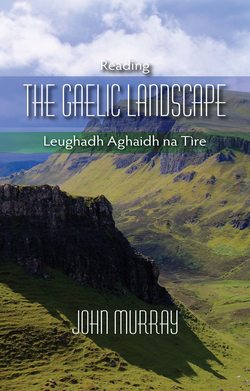Reading the Gaelic Landscape

Реклама. ООО «ЛитРес», ИНН: 7719571260.
Оглавление
John Murray. Reading the Gaelic Landscape
Contents
Acknowledgements
Preface to Second Edition
Preface to First Edition
1: Introduction
2: A Brief History of Gaelic in Scotland
Year of Census
3: Mapping the Scottish Highlands
4: A Brief Guide to Gaelic Grammar and Pronunciation
4.1: Definite Articles, Gender of Nouns and Agreement of Adjectives
4.2 Adjectives and Compound Nouns
4.3: Plural Nouns and Adjectives, and the Gaelic Spelling Rule
4.4: The Genitive Case - singular and plural
5: Place-name Classifications - Revealing Layers in the Landscape
Place-name Classifications
6: Landform and Hydrology
6.1: Mountains, Hills and Knolls
6.2: Landform - Hollows, Valleys, Ridges, Plains and Passes
6.3: Gaelic Waterscape
Coast and Sea
6.4: Still Freshwater
6.5: Running Freshwater
7: Landcover and Ecology. 7.1: Habitats, Woods and Forests
7.2: Flora
7.3: Fauna
8: Land Use. 8.1: Agriculture and Crops
Arable
Grazing
Enclosures
8.2: Transhumance and the Shieling
8.3: Domestic and Farm Animals
9: Climate, Season, Mood, Sound and Time
10: The Cultural Landscape. 10.1: Buildings, Settlements and Structures
10.2: Church and Chapel
10.3: Culture - artefacts
10.4: People and Occupations
10.5: Gaelic Anatomy
10.6: Events
10.7: Legend and the Supernatural
11: Adjectives. 11.1: Colour, Pattern and Texture
Colour Summary
Pattern
Texture
11.2: Adjectives and Adjectival Nouns - Form, Size and Position
Form, Size and Position - Position
12: Reading the Landscape through Place-names
Further Reading
Selected Bibliography. Academic Sources
Literary Sources
General Publications
Websites
Index of Specific Place-names
Index of Generic Nouns found in Place-names (excluding Proper Names)
Index of Adjectives and Adjectival Nouns
Biographical note
Отрывок из книги
Acknowledgements
Preface to Second Edition
.....
(Gillies 1938 212)
Something peculiar also happened in Glen Quaich as the OS published new editions of the map for the area. On the first edition of its 6” to the mile sheet, Easter Turrerich burn, on the north side of Loch Freuchie is shown as Allt Cù an Teumaidh – Burn of the Biting Dog. Thereafter the transparency of that name is replaced by the mix of Scots and anglicised Gaelic in Easter Turrerich (NN863388). Turraraich may be onamatopoeic and means twittering, warbling or purling. Alltan na Turraraich is in Dundonnell.
.....